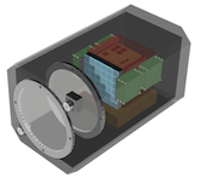Zynq board¶
Description¶
The ZynqManager class holds information on the current status of the Zynq in its public member variables. The majority of the member functions make use of socket programming to communicate with the Zynq board on the ZYNQ_IP and TELNET_PORT defined in the header file. The Zynq has several different operational modes, the key modes will be described here and for further details the reader is directed to the Zynq board documentation written and maintained by Alexander Belov (aabcad@gmail.com).
The Zynq data acquisition modes are documented here
In addition to the standard data acquisition, the Zynq can also provide S-curves. An S-curve is made by sweeping the ASIC thresholds whilst collecting data and can be used to fully characterise the PMTs, making it a powerful diagnostic tool. The ZynqManager::Scurve() takes an S-curve with the desired parameters which are passed from the configuration file by RunInstrument and DataAcquisition. S-curves can be requested from the main program by using the mecontrol -scurve command line argument.
As well as data acquisition the Zynq also handles the interface to the high voltage (HV) which is needed by the PMTs of Mini-EUSO. ZynqManager::HvpsTurnOn() is used to ramp-up the high voltage in safe steps to the desired operational level. Whenever the program is interrupted with CTRL-C (SIGINT), the ZynqManager::HvpsTurnOff() is called to ensure the HV is switched off before the program exits.
ZynqManager¶
-
class ZynqManager¶
class to handle the Zynq interface. commands and information are sent and received over telnet using socket programming. data from the Zynq board is placed on the FTP directory
Public Types
-
enum ZynqMode¶
the zynq acquisition mode options
Values:
-
enumerator NONE¶
basic modes
-
enumerator PERIODIC¶
-
enumerator SELF¶
-
enumerator IMMEDIATE¶
-
enumerator EXTERNAL¶
-
enumerator TA_TRIGGER¶
-
enumerator TRIGGER¶
compound modes
-
enumerator PERIODIC_IMMEDIATE¶
-
enumerator SELF_IMMEDIATE¶
-
enumerator PERIODIC_SELF_IMMEDIATE¶
-
enumerator PERIODIC_EXTERNAL¶
-
enumerator SELF_EXTERNAL¶
-
enumerator PERIODIC_SELF_EXTERNAL¶
-
enumerator IMMEDIATE_EXTERNAL¶
-
enumerator PERIODIC_IMMEDIATE_EXTERNAL¶
-
enumerator SELF_IMMEDIATE_EXTERNAL¶
-
enumerator ALL_TRIGGER¶
-
enumerator NONE¶
Public Functions
-
ZynqManager()¶
constructor initialises public members hvps_status, instrument_mode, test_mode and telnet_connected
-
int CheckConnect()¶
check telnet connection on ZYNQ_IP (defined in ZynqManager.h) and close the telnet connection after. has a timeout implemented of length CONNECT_TIMEOUT_SEC (defined in ZynqManager.h)
-
int GetInstStatus()¶
check the instrument status
-
int GetHvpsStatus()¶
check the HV status
-
int HvpsTurnOn(int cv, std::string hvps_dv_string, std::string hvps_ec_string)¶
turn on the HV. ramps up the dynode voltage in steps of 500 HV DAC <=> ~140 V
- Parameters:
cv – the cathode voltage (int from 1-3)
hvps_dv_string – string of N_EC dynode voltage values (HV DAC from 0 to 4096).
hvps_ec_string – string of N_EC (each EC unit) comma-separated values, 1 <=> on, 0 <=> off to convert from HV DAC to voltage use (dv/4096 * 2.44 * 466)
-
int HvpsTurnOff()¶
turn off the HV
-
int HidePixels()¶
Hide the corrupted Pixels give in DeadPixelMask.txt
-
int Scurve(int start, int step, int stop, int acc)¶
take an scurve
-
int SetDac(int dac_level)¶
set the ASIC DAC on the SPACIROCs
- Parameters:
dac_level – (0 - 1000)
-
int AcqShot()¶
acquire one GTU frame from the SPACIROCs
-
uint8_t SetZynqMode()¶
set the acquisition mode
- Parameters:
input_mode – the desired mode to set
-
TestMode SetTestMode()¶
set the test acquisition mode
- Parameters:
input_mode – the desired mode to be set
-
int SetNPkts(int N1, int N2)¶
set the number of packets for D1 and D2 required every 5.24 s
- Parameters:
N1 – the number of packets for data level 1 (1 - 4)
N2 – the number of packets for data level 2 (1 - 4)
-
int SetL2TrigParams(int n_bg, int low_thresh)¶
set the configurable parameters of the L2 trigger
- Parameters:
n_bg – the number of times above background level the threshold is set
low_thresh – the lowest possible value of the threshold
-
bool CheckScurve(int sockfd)¶
check the S-curve acquisition status and return true on completion
-
int InstrumentClean()¶
remove any files on the FTP server.
-
int Reboot()¶
Reboot the Zynq.
-
int SetMatrixDac10(const std::string &usb_mountpoint, bool debug)¶
Set the ASIC DAC10 values from a text file provided by the USB. Adapted from C. Giammanco’s script to use socket programming instead of netcat.
-
int Setup(std::string setup_script_path)¶
Performs the necessary Zynq setup following a reboot.
Public Members
-
uint8_t zynq_mode¶
stores the current zynq acquisiton mode
-
HvpsStatus hvps_status¶
stores the current HV status
-
bool telnet_connected¶
set to true if the telnet connection is successful
-
std::vector<int> ec_values¶
vector of EC values (0 <=> off, 1 <=> on)
Public Static Functions
-
static int ConnectTelnet()¶
connect via telnet to ZYNQ_IP. NB: leaves telnet open to be closed with a separate function
-
static int StopAcquisition()¶
static function to stop acquisition by setting the instrument to NONE
-
static std::string GetZynqVer()¶
get the Zynq version info
Private Functions
-
bool CheckTelnet()¶
check if the telnet socekt is responding as expected
Private Static Functions
-
static std::string SendRecvTelnet(std::string send_msg, int sockfd)¶
send and recieve commands over the telnet connection to be used inside a function which opens the telnet connection
- Parameters:
send_msg – the message to be sent
sockfd – the socket field descriptor
-
static int SendTelnet(std::string send_msg, int sockfd)¶
send a command over the telnet connection does not wait for a reply, to be used with “reboot” command to be used inside a function which opens the telnet connection
- Parameters:
send_msg – the message to be sent
sockfd – the socket field descriptor
-
static std::string Telnet(const std::string &send_msg, int sockfd, bool print)¶
wrapper for use of SendRecvTelnet() in more readable way
- Parameters:
send_msg – message to send
sockfd – the socket file descriptor
print – if true, received message is printed returns the recieved telnet response
-
static int TelnetSendOnly(std::string send_msg, int sockfd)¶
wrapper for use of SendTelnet() in more readable way
- Parameters:
send_msg – message to send
sockfd – the socket file descriptor returns 0 if successful
-
enum ZynqMode¶
